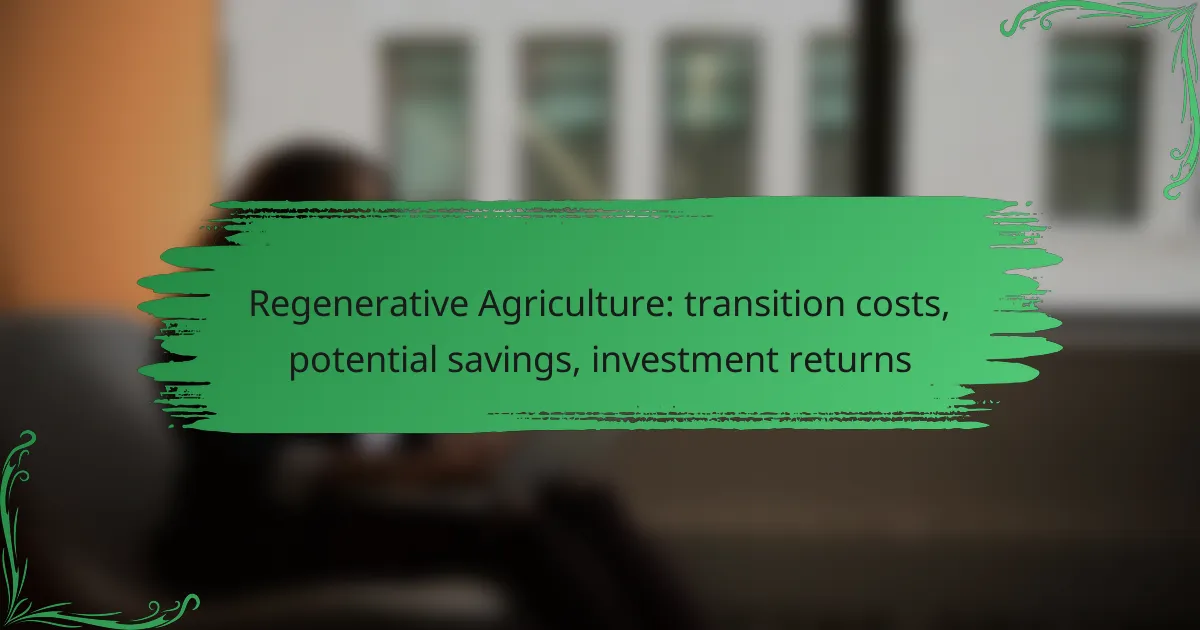Regenerative agriculture involves a complex interplay of transition costs, potential savings, and investment returns that can significantly impact farming operations. While initial investments and ongoing expenses may pose challenges, the long-term benefits include reduced input costs and enhanced soil productivity. Ultimately, the investment returns can manifest as increased yields and market premiums, making regenerative practices not only environmentally sustainable but also economically viable.
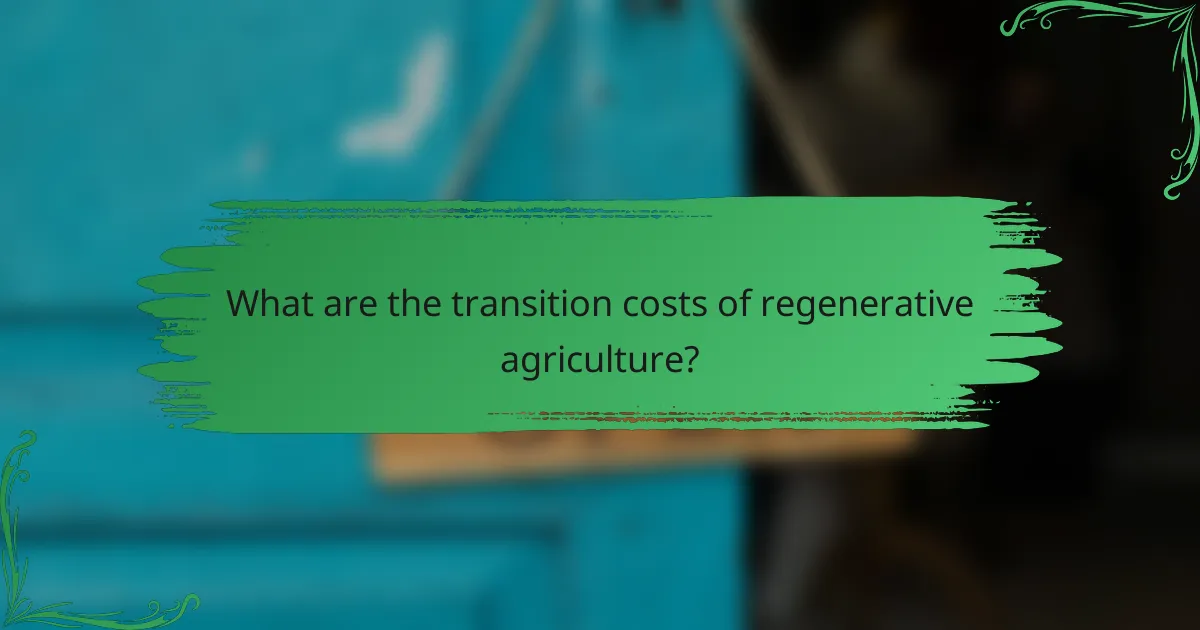
What are the transition costs of regenerative agriculture?
The transition costs of regenerative agriculture typically encompass initial investments, ongoing expenses, and potential savings over time. These costs can vary significantly based on the scale of the operation and the specific practices adopted.
Initial investment in soil health
Investing in soil health is crucial for regenerative agriculture and can involve costs for organic amendments, cover crops, and soil testing. Farmers may spend anywhere from a few hundred to several thousand dollars per hectare, depending on the practices chosen and the current soil condition.
Long-term benefits include improved soil fertility and increased crop resilience, which can lead to higher yields and reduced input costs over time. It’s essential to consider these factors when evaluating the initial investment.
Equipment and technology upgrades
Transitioning to regenerative practices often requires upgrading equipment and adopting new technologies. This may include purchasing no-till planters, specialized seeders, or precision agriculture tools, which can range from a few thousand to tens of thousands of dollars.
Farmers should assess the cost-effectiveness of these upgrades by considering the potential for increased efficiency and reduced labor costs. Additionally, some regions may offer grants or subsidies to offset these expenses.
Training and education expenses
Training and education are vital for successful implementation of regenerative agriculture practices. Costs can include workshops, online courses, or consulting services, typically ranging from a few hundred to several thousand dollars annually.
Investing in knowledge can significantly enhance the effectiveness of regenerative methods, leading to better decision-making and increased profitability. Farmers should seek out local resources or cooperative programs that may provide subsidized training opportunities.
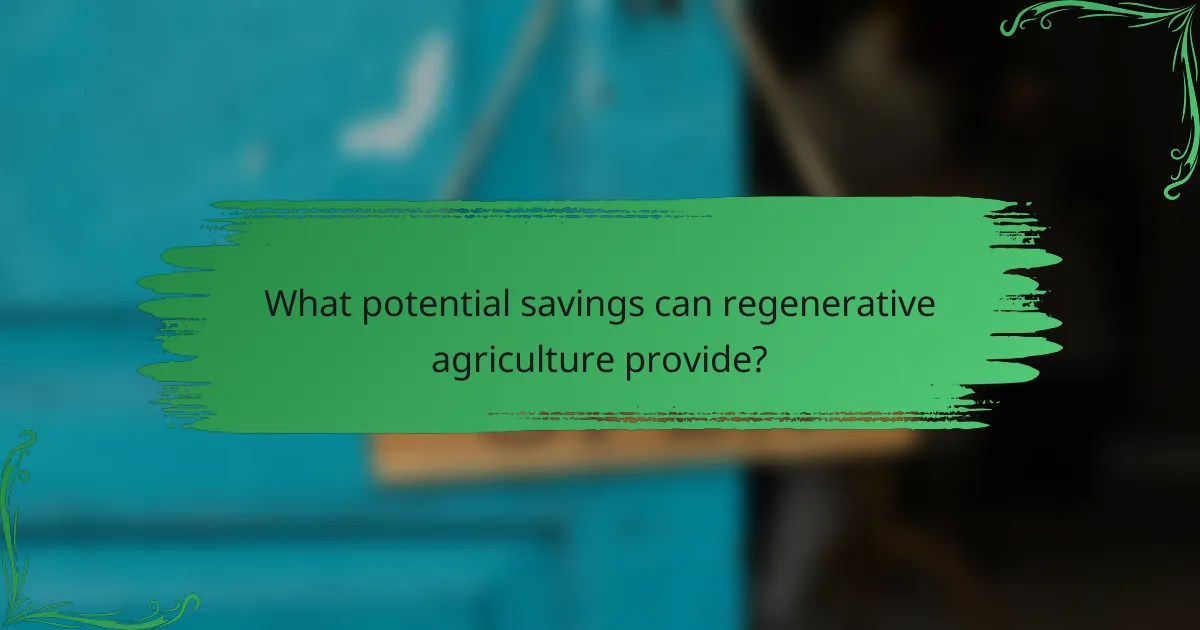
What potential savings can regenerative agriculture provide?
Regenerative agriculture can lead to significant savings by reducing input costs, lowering water usage, and enhancing long-term soil productivity. These savings not only improve farm profitability but also promote sustainable practices that benefit the environment.
Reduced input costs for fertilizers
One of the primary savings from regenerative agriculture comes from reduced reliance on synthetic fertilizers. By utilizing practices such as cover cropping and crop rotation, farmers can enhance soil fertility naturally, decreasing the need for chemical inputs.
Farmers may find that transitioning to organic fertilizers or compost can be more cost-effective in the long run, as these methods improve soil health and reduce dependency on expensive synthetic options. This shift can lead to savings of up to 30% on fertilizer costs over time.
Lower water usage and irrigation costs
Regenerative agriculture practices can significantly lower water usage, which translates into reduced irrigation costs. Techniques like no-till farming and maintaining cover crops help retain soil moisture, minimizing the need for additional watering.
Farmers adopting these methods may experience a reduction in water consumption by as much as 20-50%, depending on the region and specific practices implemented. This not only cuts costs but also conserves precious water resources, especially in areas facing drought conditions.
Long-term soil productivity savings
Investing in regenerative agriculture can lead to long-term savings through enhanced soil productivity. Healthier soils yield better crops, which can reduce the need for costly inputs over time.
By improving soil structure and biodiversity, farmers can expect increased resilience to pests and diseases, ultimately lowering the costs associated with crop loss and recovery. Over a period of years, these practices can lead to savings that significantly outweigh initial transition costs, making regenerative agriculture a financially sound investment.
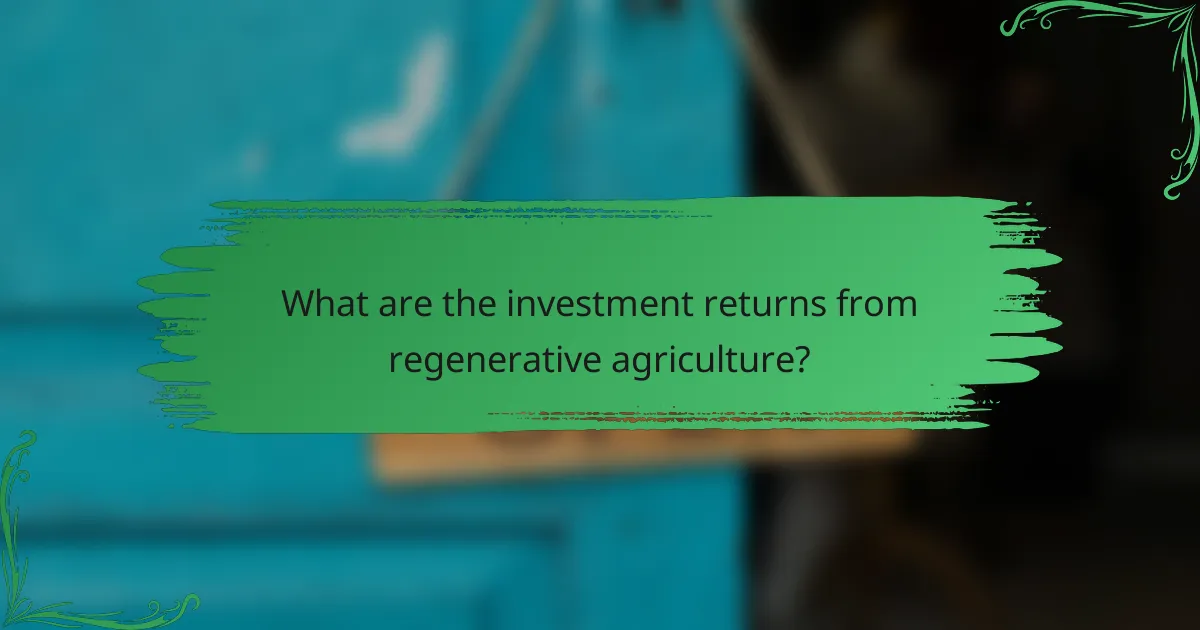
What are the investment returns from regenerative agriculture?
Investment returns from regenerative agriculture can be significant, often manifesting as increased yields, market premiums, and environmental incentives. These returns vary based on practices implemented, local markets, and specific agricultural contexts.
Increased crop yields over time
Regenerative agriculture often leads to improved soil health, which can enhance crop yields over time. Farmers may experience gradual increases in productivity as soil fertility and biodiversity improve, potentially seeing yield increases of 10-30% compared to conventional practices after several years.
To maximize these returns, farmers should focus on practices such as cover cropping, crop rotation, and reduced tillage. These methods not only boost yields but also contribute to long-term sustainability.
Market premiums for organic products
Products grown using regenerative methods can command higher prices in the market, especially if they are certified organic. Farmers may receive premiums of 20-50% over conventional products, depending on the crop and local demand.
To capitalize on this, producers should consider obtaining organic certification and marketing their products effectively. Building relationships with local consumers and retailers can also enhance visibility and sales.
Carbon credits and environmental incentives
Engaging in regenerative agriculture can qualify farmers for carbon credits and various environmental incentives. These credits can provide additional revenue streams, often valued at $10-50 per ton of carbon sequestered, depending on market conditions.
Farmers should explore local and national programs that support carbon farming initiatives. Staying informed about regulations and participating in relevant certification programs can maximize these financial benefits.
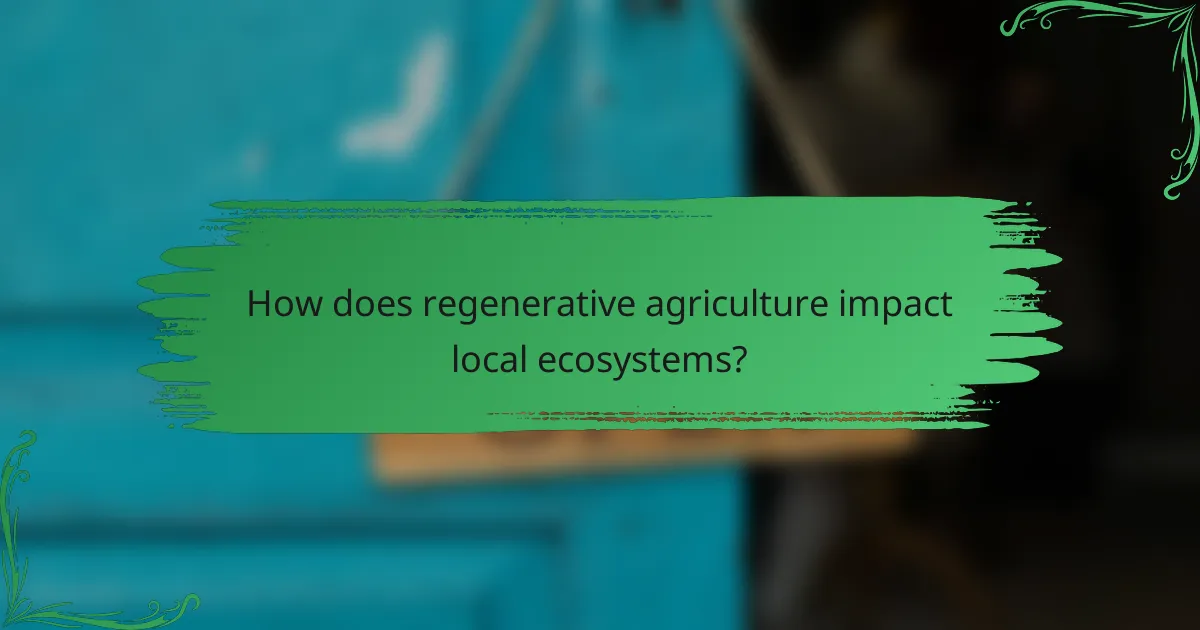
How does regenerative agriculture impact local ecosystems?
Regenerative agriculture positively influences local ecosystems by promoting practices that restore soil health, enhance biodiversity, and improve water retention. These practices not only benefit the environment but also contribute to sustainable farming systems that can yield long-term economic advantages.
Improved biodiversity in farming systems
Regenerative agriculture fosters improved biodiversity by incorporating diverse crop rotations, cover crops, and agroforestry. This variety supports a wider range of species, including beneficial insects and microorganisms, which can enhance pest control and pollination.
Farmers can consider integrating native plants and creating habitats for wildlife to further boost biodiversity. This approach not only enriches the ecosystem but can also lead to healthier crops and reduced reliance on chemical inputs.
Enhanced water retention and soil structure
Practices such as no-till farming, cover cropping, and organic amendments significantly enhance soil structure and water retention. Healthy soil can absorb and retain moisture more effectively, which is crucial during dry periods and can reduce irrigation costs.
Farmers should aim to build organic matter in the soil, as this can improve its ability to hold water. Simple methods like adding compost or using mulch can make a substantial difference in soil health and water management.
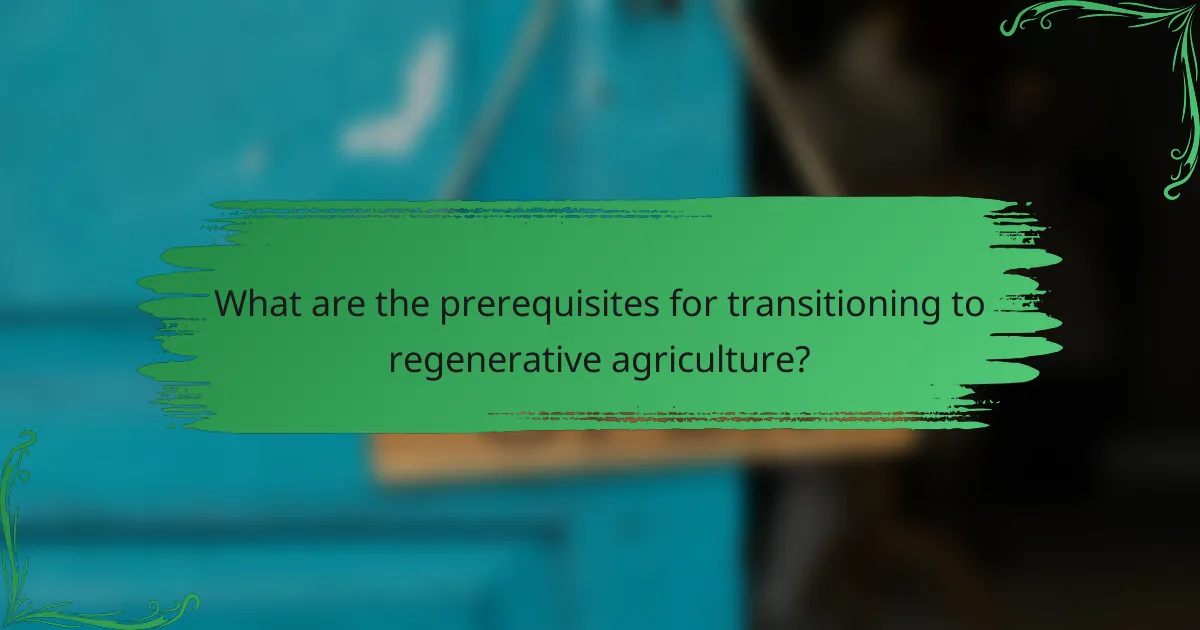
What are the prerequisites for transitioning to regenerative agriculture?
Transitioning to regenerative agriculture requires a thorough understanding of current practices and local environmental conditions. Farmers must assess their existing methods and soil health to effectively implement regenerative techniques.
Assessment of current farming practices
Evaluating current farming practices is essential for a successful transition to regenerative agriculture. This assessment should include a review of crop rotation, soil management, and pest control methods. Identifying areas for improvement can help farmers determine which regenerative practices will be most beneficial.
Farmers should consider adopting practices such as cover cropping, reduced tillage, and integrated pest management. These methods can enhance soil health and biodiversity, leading to long-term sustainability and potential cost savings.
Understanding local soil conditions
Understanding local soil conditions is crucial for implementing regenerative agriculture effectively. Soil type, structure, and nutrient levels vary widely across regions, influencing the choice of crops and management practices. Conducting soil tests can provide valuable insights into the specific needs of the land.
Farmers should focus on improving soil organic matter and microbial activity, which are vital for nutrient cycling and water retention. Techniques such as composting and mulching can enhance soil health and resilience, ultimately supporting more productive and sustainable farming systems.

How to choose the right regenerative practices?
Selecting the right regenerative practices involves assessing your specific agricultural context, including soil health, climate, and crop types. Prioritize methods that enhance biodiversity and soil fertility while considering the economic implications of each practice.
Evaluating crop rotation strategies
Crop rotation is a vital regenerative practice that helps improve soil health and reduce pest pressures. Consider rotating crops with different nutrient needs and growth habits to enhance soil structure and fertility. For example, alternating deep-rooted plants with shallow-rooted ones can optimize nutrient uptake.
When evaluating rotation strategies, assess local climate conditions and market demand for various crops. A successful rotation might include legumes to fix nitrogen followed by cereals that benefit from this nutrient boost. Aim for rotations that last several years to maximize benefits.
Identifying suitable cover crops
Cover crops are essential for preventing soil erosion and enhancing soil organic matter. Choose cover crops based on your primary crops, soil type, and local climate. Common options include clover, rye, and vetch, which can improve soil structure and nutrient availability.
When selecting cover crops, consider their growth habits and potential benefits, such as weed suppression and nitrogen fixation. Planting cover crops during off-seasons can significantly enhance soil health and reduce the need for synthetic fertilizers. Aim for a diverse mix to maximize ecological benefits and resilience.

What are the challenges in adopting regenerative agriculture?
Adopting regenerative agriculture presents several challenges, including financial investment, knowledge gaps, and resistance from established farming practices. Transitioning to these sustainable methods requires commitment and a willingness to change long-standing habits.
Resistance from traditional farming communities
Resistance from traditional farming communities is a significant barrier to adopting regenerative agriculture. Many farmers are accustomed to conventional practices that prioritize short-term yields over long-term sustainability, making them hesitant to embrace new methods.
To overcome this resistance, it is essential to engage with these communities through education and demonstration. Highlighting successful case studies and providing hands-on training can help illustrate the benefits of regenerative practices, such as improved soil health and increased biodiversity.
Building trust and showing tangible results can gradually shift perceptions. Farmers may be more open to change if they see potential cost savings and enhanced productivity from regenerative techniques over time.
